Custom Covers utilizes technology to stay on top
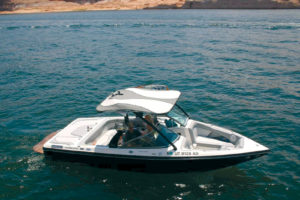 Top. The dictionary has numerous definitions for the word. For Custom Covers, a marine fabrication business based in Salt Lake City, the word takes on its own meanings.
Top. The dictionary has numerous definitions for the word. For Custom Covers, a marine fabrication business based in Salt Lake City, the word takes on its own meanings.
Top, as in boat top, is what the company manufactures.
Top, as in top of the market, is where the company has been since creating the first custom bimini top and proprietary hardware for the ski tower, a new accessory trend for tournament-type ski boats and runabouts.
Top, as in the top in the industry, is how the company wants to be recognized when it reaches its goals.
Starting a marine canvas business wasn’t on the top of Justin Jones’ mind a little more than six years ago. He learned upholstery skills and received an introduction to the fabric side of the industry while working for his father’s successful upholstery business, also in Salt Lake City, and holding positions with industry suppliers. But he never really prepared for starting and running his own business. That happened almost by accident.
“I had a friend who started to sell boats, and he talked me into making a couple of boat covers,” says Jones, 32, who started Custom Covers in 2002 after making the transition from his father’s upholstery shop, where he worked as far back as he can remember. “From there, I went to the 1999 IFAI Expo to look for suppliers and equipment, and attended seminars on marine fabrication—and learned a lot. I found this Gemini hinge, which I thought was the coolest thing, and wondered how I could use it to build a top. So, I got a piece of metal and started bending the frame and put some hinges on it. I installed it on my boat, and it worked.”
Perfect timing
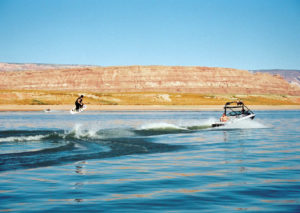
The popularity of wakeboarding catapulted the tower to being a standard feature of most ski boats-creating new opportunities for marine fabricators.
Fortunately for Jones, just about the time he was envisioning his business, wakeboarding became tops in popularity, creating the need and demand for the tower: framework mounted to a boat, designed to create an upward pull on skiers to launch them high into the air. The good news for Custom Covers is that with the popularity, variety and complexity of new tower models, there is a demand by boat owners for unique shade solutions.
“Without the towers there’d be no tops; this trend has been our whole business,” says Jones, who is credited with pioneering the bimini top for the tower frame.
Custom Covers has focused its efforts on creating tops for towers, specifically two models called the Folding Trampoline and Folding Canopy, which have been its niche—and its forte. The shop’s full line of services includes snap-on covers for travel, and tie-on covers for storage, mostly for 18-foot to 24-foot boats. The two tower tops make up 50 percent of Custom Covers’ business. Jones says the tops are more popular and profitable than the company’s other products. Plus, it’s what the company’s reputation is built on.
Custom Covers uses Glen Raven Coastguard, a solution-dyed acrylic, in the fabrication of most of its bimini tops. Because of the dry environment in Salt Lake City, people aren’t looking for water protection as much as sun protection. Due to heavy snow loads in the winter, the company uses MarChem’s acrylic-coated polyester, Top Gun, for its storage covers.
“The vinyl-coated polyesters haven’t held up as well,” Jones says. “I’ve seen some of them come back for repair. For our snap-on covers, we use Sunbrella because of its longevity. It breathes and gives a certain amount of water protection, and it’s got a nicer hand. Around here, the average consumer is a weekend warrior, so the tops get about 100 hours of sun exposure per year. They don’t wear out as quickly as a tie-on cover that sits out 24 hours a day, 365 days a year.”
Fifty percent of Custom Covers’ customer base comes from local marine dealers, two of whom use the company exclusively. The other 50 percent are retail customers, who come mainly by word of mouth from dealer and customer referrals.
-
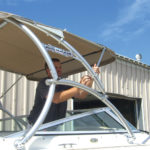
- Jones started Custom Covers in 2002, after applying skills he learned working in his father’s upholstery shop to fabricating boat covers.
-
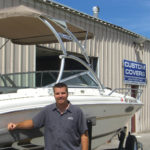
- The folding canopy, which is the most popular top with Jones’ customers, is one of two tower top models that Jones created to meet growing demand.
Marketing strategies
Jones admits that he doesn’t do much marketing. He refers to what he does as “guerilla” marketing. “I really take care of my dealers and their employees, making sure they’re promoting my business as much as they can,” he says. “I also exhibit at the Salt Lake City Boat Show every year. It allows us to be face to face with potential customers and sell our product and its quality. That’s where we get most of our new customers.”
Jones admits that he doesn’t do much marketing. He refers to what he does as “guerilla” marketing. “I really take care of my dealers and their employees, making sure they’re promoting my business as much as they can,” he says. “I also exhibit at the Salt Lake City Boat Show every year. It allows us to be face to face with potential customers and sell our product and its quality. That’s where we get most of our new customers.”
Most of Custom Covers’ customers are from the greater Salt Lake area. The company has a dealer in Idaho and has made a number of sales in Texas. “It’s a goal to go national,” says Jones, who admits that that aspect of business could use more marketing. “But I’m not sure I’m ready for it yet. I’ve got a lot more business here that I’m turning away because I can’t do it fast enough. That’s my primary focus. Once we’re caught up, I’ll look at markets in other areas.”
Growing pains
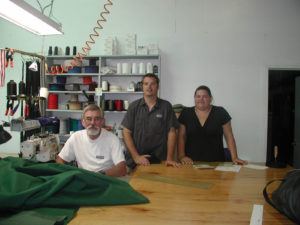
Custom Covers has grown to include four full-time, year round employees: Rick Burgin, Justin Jones, Melissa Oaks and Kenny England ( not pictured).
The company’s rise to the top of the tower wasn’t immediate; it had its ups and downs. “The first year was hit or miss. I worked on 10 or 20 boats, and profits were minimal,” Jones, the company’s only employee that year, says. “But then I really tried to make a business of it after I realized it had potential.”
During that time, Custom Covers shared a 1,500-square-foot facility with Jones’ father’s business. The agreement allowed Jones to continue to work for his father and concentrate on his boat work during the off times. There weren’t many off times.
“Every year up until last year, the business has grown anywhere from 20 to 50 percent over previous years,” says Jones, who, out of necessity and opportunity, hired seasonal help the second year, and during year three, hired a full-time shop manager, Rick Burgin. The company now has four full-time, year-round employees, including Jones. “Last year we only grew by about 10 percent, and I think that was because we were limited by our space,” he says. “We just couldn’t really grow.”
To test that theory, Jones moved Custom Covers uptown to a 3,000-square-foot building. Business is already up 25 percent over last year, with total sales in the $300,000 range. Jones doesn’t know exactly how many boats come to his shop per year, but says the crew fabricates about 200 Folding Canopy and Folding Trampoline tops.
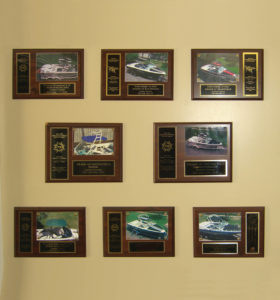
MFA Awards of Excellence and Awards of Distinction displayed in his shop contribute to Jones’ marketing strategies.
With success come challenges. Jones says his biggest challenge has been managing the growth of the business—all things from cash flow to employee management to keeping up with the orders.
“Right now the company’s biggest challenge is information sharing and workflow,” says Jones, who is tying to specialize the departments at Custom Covers instead of having one employee complete a project from start to finish.“We’re trying to figure out the workflow through those departments because our tops are becoming more standardized—kind of an assembly-line philosophy.
“My latest kick is having a checklist that goes with each project, so the key elements are completed with each job. Employees need to know that it’s done properly and correctly so we get the same finished product every time.”
The shapes and designs of towers have changed since Jones fabricated his first top. Knowing that Custom Covers needed to alter its processes to accommodate these changes, it has engineered its proprietary clamps so they are universal among all tower styles. The Folding Canopy works on almost all towers, and although the company tries to standardize its products, it is able to accommodate different tower styles and sizes.
“We make our own custom clamps to secure the top to the tower,” Jones says. “We used to drill holes through the framework of the tower and secure the top with a bolt or pin, which was pretty crude. Now, everything clamps to the tower, and we don’t need to drill any holes. This allows us to package and ship our products to customers in other locations.”
Traditional and progressive
To fabricate its products with high-quality standards, Custom Covers uses traditional methods and tools, including Canvex for patterning, hot knives and lock-stitch sewing machines. Purchasing new technology is at the top of the company’s to-do list.
“CAD/CAM technology is something we’re very eager to learn and use,” Jones says of the business, which has a goal of purchasing an automatic cutting table by the end of 2008, and digitizing hardware within a year after that. “We will be one of the companies that drives the way CAD and automated processes come to the marine canvas business. There’s no product you can buy to do marine canvas, so people are buying other products and adapting them. I think this technology will really take our business through the roof, especially because it would cut the patterning and cutting production way down—and increase quality.
“It wasn’t that long ago when I was looking at cutting tables and thought, ‘I can’t afford that,’” Jones explains. “Now my thinking is, ‘How can’t I afford that?’ I’ve realized the value new technology can play in my business.”
Looking to the future, Jones is optimistic about the potential of Custom Covers. But beyond building his business, Jones has a more dynamic and benevolent goal to help the marine fabrication industry.
-
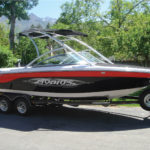
- The popularity of wakeboarding has made the tower a standard feature on most ski boats. New tower trends offer a wide variety of designs and alternative materials.
-
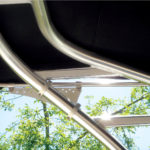
- In addition to creating the Folding Canopy and Foldine Trampoline bimini tops to accommodate boat towers, Jones also designs the proprietary hardware, including hinges and clamps, necessary to install the tops to the framework of the towers.
“I see myself as one of the industry leaders in shop efficiency,” he says. “I’m on a mission to really standardize the canvas business. I want to streamline the process—the entire business concept of marine canvas—and develop a business model using technology. My retirement is to make a business model that I could sell to anyone, providing the means and the documentation in place to run the business.
“By standardizing the industry, we can build more professionalism into it and make everyone aware that there are additional standards that the members of the industry can help establish so that everyone in the industry can benefit.”
For a relatively young business owner, who can be considered a pioneer in the industry, Jones remains humble and welcomes competition—even as potential opponents try to pilfer his ideas.
“I’ve only seen one or two direct knock-offs,” he says. “I like seeing different versions because I think they’re not as good as ours. But I like seeing what other people are doing and wonder how we can take a little bit of what they’re doing and a little bit of what we’re doing and make something better. I’m always eager and curious to see it, but I’ve yet to see a perfect top. Every top has its pros and cons. Custom Covers’ tops have the least amount of cons and most pros. But it’s the customer who ultimately decides what’s the best.”
Chris Tschida is the editor of Marine Fabricator.
 TEXTILES.ORG
TEXTILES.ORG 






